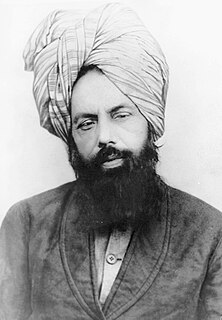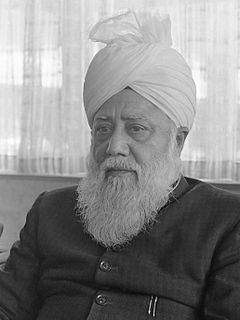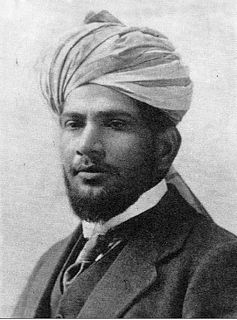
Mirzā Ghulām Ahmad was an Indian religious leader and the founder of the Ahmadiyya movement in Islam. He claimed to have been divinely appointed as the promised Messiah and Mahdi—which is the metaphorical second-coming of Jesus (mathīl-iʿIsā), in fulfillment of Islam's latter day prophecies, as well as the Mujaddid of the 14th Islamic century.

The Lahore Ahmadiyya Movement for the Propagation of Islam, is a separatist group within the Ahmadiyya movement that formed in 1914 as a result of ideological and administrative differences following the demise of Hakim Nur-ud-Din, the first Caliph after Mirza Ghulam Ahmad. Members of the Lahore Ahmadiyya movement are referred to by the majority group as ghayr mubāyi'īn and are also known colloquially as Lahori Ahmadis.

The Ahmadiyya Caliphate is a non-political caliphate established on May 27, 1908 following the death of Mirza Ghulam Ahmad, the founder of the Ahmadiyya Muslim Community, who claimed to be the promised Messiah and Mahdi, the expected redeemer awaited by Muslims. It is believed by Ahmadis to be the re-establishment of the Rashidun Caliphate that commenced following the death of the Islamic prophet Muhammad. The caliphs are entitled Khalīfatul Masīh, sometimes simply referred to as Khalifa. The caliph is the elected spiritual and organizational leader of the worldwide Ahmadiyya Muslim Community and is the successor of Ghulam Ahmad. He is believed by the Community to be divinely ordained and is also referred to by its members as Amir al-Mu'minin and Imam Jama'at. The 5th and current Caliph of the Messiah of the Ahmadiyya Community is Mirza Masroor Ahmad.

Hāfiz Mirza Nasir Ahmad was the third caliph, head of the Ahmadiyya Community. He was elected as the third successor of Mirza Ghulam Ahmad on 8 November 1965, the day after the death of his predecessor and father, Mirza Basheer-ud-Din Mahmood Ahmad.

Mirza Basheer-ud-Din Mahmood Ahmad, was the second caliph, leader of the worldwide Ahmadiyya Muslim Community and the eldest son of Mirza Ghulam Ahmad from his second wife, Nusrat Jahan Begum. He was elected as the second successor of Mirza Ghulam Ahmad on 14 March 1914 at the age of 25, the day after the death of his predecessor Hakim Nur-ud-Din.

Mirza Masroor Ahmad is the current and fifth leader of the Ahmadiyya Muslim Community. His official title within the movement is Fifth Caliph of the Messiah. He was elected on 22 April 2003, three days after the death of his predecessor Mirza Tahir Ahmad.

The Basharat Mosque or Masjid Basharat is a mosque in Pedro Abad, Córdoba, Spain. The foundation stone was laid by the then head of worldwide Ahmadiyya Muslim Community, Mirza Nasir Ahmad on October 9, 1980. It is the first purpose-built mosque since the end of Muslim rule at the end of the 15th century. It was inaugurated on 10 September 1982 by the fourth head of Ahmadiyya Muslim Community, Mirza Tahir Ahmad. The mosque is the centre of Ahmadiyya-Movement in Spain.

Ahmadiyya is an Islamic branch in Switzerland, under the spiritual leadership of the caliph in London. The Community was founded on October 13, 1946, during the late period of the Second Caliphate, when the caliph directed Shaikh Nasir Ahmad to establish a mission in the country. Today there are two Ahmadi mosques and 14 local branches, representing an estimated 800 Ahmadi Muslims.

Ahmadiyya, officially the Ahmadiyya Muslim Community or the Ahmadiyya Muslim Jama'at, is an Islamic revival or messianic movement originating in Punjab, British India, in the late 19th century. It was founded by Mirza Ghulam Ahmad (1835–1908), who claimed to have been divinely appointed as both the Promised Mahdi and Messiah expected by Muslims to appear towards the end times and bring about, by peaceful means, the final triumph of Islam; as well as to embody, in this capacity, the expected eschatological figure of other major religious traditions. Adherents of the Ahmadiyya—a term adopted expressly in reference to Muhammad's alternative name Aḥmad—are known as Ahmadi Muslims or simply Ahmadis.

The Review of Religions is an English-language comparative religious magazine published monthly by the Ahmadiyya Muslim Community. Regularly in print since 1902, it is one of the longest running Islamic periodicals in English. It has been described as the main publication of the Ahmadiyya movement in the language and as a valuable source material for information on the geographical expansion of Ahmadi activity. The magazine was launched by Mirza Ghulam Ahmad with the aim of conveying an accurate understanding of Islamic teachings across the English-speaking world and dispelling misconceptions held against the faith. The articles, however, typically comprise distinctly Ahmadi perspectives. In addition to the English edition published from London, the magazine currently publishes separate quarterly editions in German, French and Spanish.

Jāmi’ah al-Ahmadīyyah is an International Islamic seminary and educational institute with campuses in Pakistan, United Kingdom, India, Ghana, Canada, Germany, Nigeria, Indonesia, Bangladesh, Malaysia, Tanzania, Sri Lanka, Sierra Leone, and Kenya. In addition, there are affiliated Mu'alameen centers in Pakistan and Madagascar. Founded in 1906 as a Section in Madrassa Talim ul Islam by Mirza Ghulam Ahmad of Qadian, the founder of the Ahmadiyya Muslim Community, it is the main centre of the Ahmadiyya Muslim Community for Islamic learning.

Ahmadiyya Muslim Community was established in United Kingdom with the pioneering efforts of Chaudhry Fateh Muhammad Sial, who arrived in London in July in 1913. Sial was the first missionary sent overseas by the Ahmadiyya Muslim Community and was under the direction of Hakeem Noor-ud-Din, the first caliph of the movement.

Chaudhry Fateh Muhammad Sial (1887–1960) was a companion of Mirza Ghulam Ahmad and the first Ahmadi missionary sent from India, under the leadership of Hakeem Noor-ud-Din, the first Khalifa of the Ahmadiyya movement. In 1913, Mirza Basheer-ud-Din Mahmood Ahmad asked for volunteers to serve as Ahmadi Muslim missionaries in England. Sial volunteered and travelled to England on June 22, 1913 and arrived the following month. There he served twice as a missionary. He earned an MA in Arabic from the Aligarh Muslim University.

Ahmadiyya in The Gambia is part of the worldwide Ahmadiyya Muslim Jama'at under the leadership of the Ahmadiyya Caliphate. Ahmadiyya teachings entered Gambia during the era of the Second Caliphate through the flow of Ahmadiyya literature and a number of traders returning to the country. The first missionary to enter the country was Alhaji Hamza Sanyaolo, a Nigerian who entered in 1959. After a number of months he was followed by Gibriel Saeed, a Ghanaian missionary. Since its earliest history in the Gambia, the Community has been facing resistance and religious intolerance from certain Muslim clerics and Islamic bodies in the country.

Ahmadiyya is an Islamic community in Japan. The history of the Ahmadiyya Muslim Community in Japan begins after a number of mentions by Mirza Ghulam Ahmad, who showed a particular interest in introducing Islam to the Japanese people. The first Ahmadi Muslim missionary to be sent to Japan was Sufi Abdul Qadeer, who was sent by the second Caliph. He arrived in Japan on June 4, 1935. Today there is one purpose-built mosque, the largest in the country, representing an estimated 300 Ahmadi Muslims.

Ahmadiyya is an Islamic branch in Denmark, under the spiritual leadership of the caliph in London. Kamal Yousuf, an Ahmadi Muslim missionary, who was appointed for disseminating Ahmadiyya teachings in Scandinavia, first toured Denmark in 1956. The earliest Danes to have converted to the movement were from the 1950s and the Community was first established in 1959, during the last few years of the Second Caliphate. Today, there are two Ahmadi mosques, of which one is purpose-built mosque, the oldest in the country. There are an estimated 600 Ahmadi Muslims in the country.

Ahmadiyya is an Islamic movement in Australia, first formally founded in the country in the 1980s, during the era of the fourth caliph. However, the history of the Community dates back to the early 20th century, during the lifetime of the founder of the movement, Mirza Ghulam Ahmad, with the first contacts arising as a consequence of Australians travelling to British India, and also as a consequence of early, "Afghan" camel drivers settling in Australia during the mid to late 19th century. Today there are at least four Ahmadi mosques in four of the six Australian states, representing an estimated 6,000-8,000 Australian Ahmadis in the country.

Ahmadiyya is an Islamic religious community in Singapore. The Community was established during the era of the Second Caliphate, shortly before the Second World War. Ghulam Hussain Ayyaz was the first missionary sent to the region, who under the direction of the caliph, arrived in 1935, in a period when the territory was part of the Straits Settlements. In the 1970s, the Community had roughly 200 followers, represented by 1-2% of the Muslim population.

The Nusrat Jahan Mosque or The Nusrat Djahan Moske is an Ahmadiyya Mosque built on the outskirts of Copenhagen, Denmark in Hvidovre.














